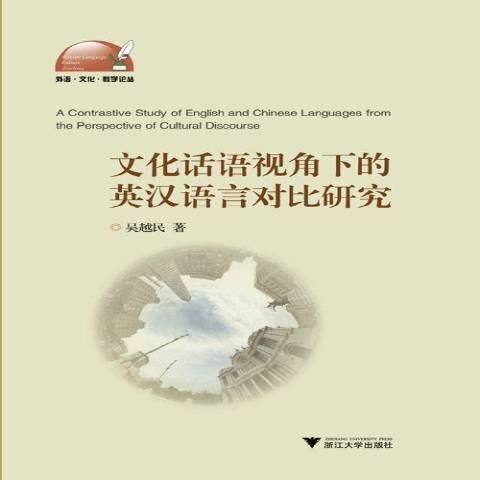內容簡介
本書採用中英雙語寫作。語言與文化相互制約、相互影響——文化中有語言、思維和情感,語言中有思維、情感和文化。本書的創新之處在於把當代話語分析理論運用到中英語言和文化的比較中,把語言與文化結合起來研究,從文化現象去闡釋語言,探討文化對語言的形成和制約作用以及英漢語言的人文屬性,同時又從語言現象去闡釋文化,以語言為媒介來介紹文化,探究語言現象中隱含的民族文化心理,比較中英語言之間的差異和共性。
圖書目錄
Chapter 1 Language and Culture
1.1 Language
1.1.1 The Definition of Language
1.1.2 The Components of Language
1.1.3 The Characteristics of Language
1.2 Culture
1.2.1 The Definition of Culture
1.2.2 The Components of Culture
1.2.3 The Characteristics of Culture
1.2.4 The Elements of Cultural Patterns
1.2.5 High-context and Low-context Cultural Patterns
1.2.6 Culture and Related Terms
1.3 Relationship between Language and Culture
1.3.1 Language Is Part of Culture
1.3.2 Language Is the Carrier and Container of Culture
1.3.3 Language Is Strongly Influenced and Shaped by Culture
1.3.4 Language Exerts Its Influence on Culture
1.3.5 Language and Culture Influence and Shape Each Other.
Chapter 2 Discourse and Semiotics
2.1 Discourse
2.1.1 The Definition of Discourse
2.1.2 Language and Discourse
2.1.3 The Definition of Discourse Analysis
2.1.4 Cultural Discourse
2.2 Semiotics
2.2.1 The Definition of Semiotics
2.2.2 Sign Systems
2.2.3 Cultural Semiotics
2.2.4 Codes
2.2.5 Symbols
2.2.6 Semiotic Analysis
Chapter 3 Semantics and Contexts
3.1 Semantics
3.1.1 Word Meanings
3.1.2 ConceptualMeanings andAssociative Meanings
3.2 Contexts
3.2.1 Social Contexts
3.2.2 Cultural Contexts
3.3 Semantic Differences
3.3.1 Words with Basically the Same Conceptual and Associative Meanings
3.3.2 Different Words Conveying the Same Cultural Meanings
3.3.3 Same Words Conveying Different Associative Meanings
3.3.4 Words with Surface Similarity butActual Semantic Differences
3.3.5 Lexical Gaps in Different Cultures
Chapter 4 Animals and Plants
4.1 Animals
4.1.1 Dog(狗)
4.1.2 Fish(魚)
4.1.3 Sheep(羊)
4.1.4 Horse(馬)
4.1.5 Lion(獅)
4.1.6 Tiger(虎)
4.1.7 Cattle(牛)
4.1.8 Rabbit(兔)
4.1.9 Tortoise(龜)
4.1.10 Owl(貓頭鷹)
4.1.11 Bat(蝙蝠)
4.1.12 Crane(仙鶴)
4.1.13 Magpie(喜鵲)
4.2 Plants
4.2.1 Rose(玫瑰)
4.2.2 Plum(梅),Orchid(蘭),Bamboo(竹)and Chrysanthemum(菊)
4.2.3 Pine(松)
4.2.4 Bodhi Tree(菩提樹)
4.2.5 Lotus(蓮花,荷花)
4.2.6 Apple(蘋果)
4.2.7 Peach(桃)
4.2.8 Willow(柳)
Chapter 5 Colors and Numbers
5.1 Colors
5.1.1 Red(紅)
5.1.2 White(白)
5.1.3 Black(黑)
5.1.4 Green(綠)
5.1.5 Yellow(黃)
5.1.6 Blue(藍)
5.1.7 Grey(灰)
5.1.8 Pink(粉紅)
5.1.9 Purple(紫)
5.2 Numbers
5.2.1 One(一)
5.2.2 Two(二)
5.2.3 Three(三)
5.2.4 Four(四)
5.2.5 Five(五)
5.2.6 Six(六)
5.2.7 Seven(七)
5.2.8 Eight(八)
5.2.9 Nine(九)
5.2.10 Ten(十)
5.2.11 Thirteen(十三)
Chapter 6 Grammar and Text
6.1 Grammar
6.1.1 Morphemes
6.1.2 Syntactical Rules
6.1.3 Explicit Grammar and Implicit Grammar
6.1.4 Subjects and Objects
6.1.5 Paratactic and Hypotactic Relations
6.1.6 Branching and Linear Sentence Patterns
6.1.7 Word Order
6.1.8 Cultural Differences behind Grammar
6.2 Text
6.2.1 The Definition of Text
6.2.2 Cohesion and Coherence
6.2.3 Textual Connectives
6.2.4 Textual Structures
6.2.5 Cultural Differences behind Text
Chapter 7 Simile and Metaphor
7.1 Simile
7.1.1 The Definition of Simile
7.1.2 Cultural-alike Associations in English and Chinese Similes
7.1.3 Cultural-distinct Associations in English and Chinese Similes
7.2 Metaphor
7.2.1 The Definition of Metaphor
7.2.2 Cultural Metaphors
7.2.3 Cultural-alike Associations in English and Chinese Metaphors.
7.2.4 Cultural-distinct Associations in English and Chinese Metaphors
7.3 Translation
7.3.1 Literal Translation
7.3.2 Cultural Translation
Chapter 8 Idioms and Proverbs
8.1 Idioms
8.1.1 Cultural Similarities between Chinese and English Idioms
8.1.2 Cultural Disparities between Chinese and English Idioms
8.2 Proverbs
8.2.1 Some Equivalent Proverbs in English and Chinese
8.2.2 Proverbs Related to Different Religions
8.2.3 Proverbs Derived from Literary Works
8.2.4 Proverbs Originating from Geographical Environments
8.2.5 Proverbs Reflecting Values and Viewpoints
Chapter 9 Allusions and Euphemisms
9.1 Allusions
9.1.1 Allusions from Literature
9.1.2 Allusions from History
9.1.3 Allusions from Mythology and Legends
9.1.4 Allusions from Sports
9.1.5 The Contrastive Analysis of English and Chinese Allusions
9.2 Euphemisms
9.2.1 To Avoid Taboos
9.2.2 To Show Politeness
9.2.3 To Conceal Truth
Chapter 10 Taboos and Sexism
10.1 Taboos
10.1.1 The Definition of Taboo
10.1.2 Verbal Taboos in Different Cultures
10.1.3 Nonverbal Taboos in Different Cultures
10.2 Sexism
10.2.1 Sexist Language in English
10.2.2 Sexist Language in Chinese
Chapter 11 Advertising and Culture
11.1 The Definition of Advertising
11.2 The Development of Advertising
11.2.1 The Evolution of Western Advertising
11.2.2 Chinese Economic Reform and Advertising
11.3 The Techniques of Advertising
11.4 The Linguistic Features of Advertising
11.4.1 Phonetic Features of Advertisements
11.4.2 Lexical Features of Advertisements
11.4.3 Rhetorical Devices of Advertisements
11.5 Brand Names
11.5.1 Brand Names and Cultural Connotations
11.5.2 Coinages in English and Chinese Brand Names
11.5.3 Exotic Flavor in English and Chinese Brand Names
11.5.4 Cultural Connotations in English and Chinese Brand Names
11.6 Logos
11.7 Cultural Differences in English and Chinese Advertising
11.7.1 Advertising Legislations in Different Cultures
11.7.2 Family Image in Chinese Advertisements
11.7.3 Authoritative Worship and Factual Proofs
11.7.4 Collective Orientation and Individualistic Centeredness
Glossary (Index of Important Terms)
Bibliography

